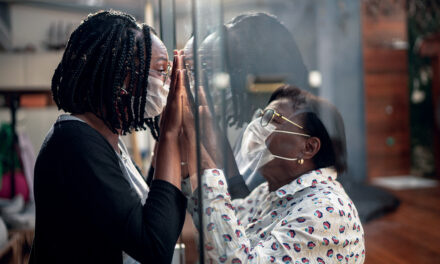Lung cancer is the leading cause of cancer death among women. Smoking is a risk factor, but not the only one. Here’s what you need to know.
Lung cancer kills more women annually than breast, uterine, and ovarian cancer combined. And yet, only 1 percent of women have lung cancer as a top-of-mind concern. Many see lung cancer as closely tied to smoking, but one in five women who develop lung cancer has never smoked. While smoking remains the greatest risk factor for developing lung cancer and the rate of new cases has continued to decline as fewer people smoke, there are numerous other risk factors. That’s why the American Lung Association (ALA) and other lung-disease advocates are on a full-court press to spread the word to women about this silent epidemic.
Lung Cancer Basics
There are a host of variables that account for cancer among non-smokers, with exposure to radon, air pollutants, and secondhand smoke the most common. The role of estrogen is still a matter under scientific investigation. Studies have shown that women who have had hormone replacement with estrogen and progesterone have the highest incidence of a type of cancer called adenocarcinoma, while women who’ve taken the estrogen blocker have a statistically lower risk. This points to some kind of hormone involvement with the disease.
There are two main categories of lung cancer that account for the vast majority of cases, both usually described as “non-small cell carcinomas.”
Squamous cell carcinomas: Typically found in the central part of the lung, or in the right or left lobes, these malignancies present themselves in common symptoms like a persistent cough, trouble breathing (especially with exertion), pain in the chest, and blood in the sputum after coughing. This type of cancer is strongly associated with smoking.
Adenocarcinomas: Generally involving cells on the periphery of the lungs, this type of cancer, in terms of its symptons, is so subtle and difficult to recognize in early stages that it can easily be mistaken for a host of other conditions. Adenocarcinoma symptoms often consist of fatigue, mild aches in the back, chest, or shoulders, and mild shortness of breath.
For women, early detection of adenocarcinomas is especially crucial. “Recent studies showed a 10–14 percent higher incidence in women than men,” says Scott Kindsfather, M.D., medical director of Medical Oncology at Capital Health. “The good news is that women are more likely to have the epidural growth factor receptor or anaplastic lymphoma kinase mutations that respond well to new targeted agents. Women who have abnormalities in those molecular changes tend to do better.”
Screening Advances
About 70 percent of lung cancer patients are diagnosed after the disease has spread elsewhere in the body, so new methodologies in early lung cancer screening are projected to be important game-changers. A recent trial published in the New England Journal of Medicine demonstrated a 20 percent mortality benefit for high-risk patients who undergo a simple CT chest scan.
Andrea McKee, M.D., national spokesperson for the American Lung Association (ALA) and a women’s health specialist, says that lung cancer screening through low dose CT scans is a major development: “If we focus on the high-risk population (roughly 9 million people), Health and Human Services estimates that at least 10,000 lives can be saved per year. We’ve just never seen that kind of progress in lung cancer, ever,” she says.
High-risk individuals are those 55 and older with a 30 “pack-year” smoking history. Pack-years are the number of packs smoked per day times the number of years a person smoked. So a woman who smoked one pack of cigarettes per day for 30 years and one who smoked two packs a day for 15 years have the same 30-pack-a-year history.
Getting screened before the disease is firmly entrenched can make a profound difference in a patient’s outcome. “Eighty-five percent of the patients we screen who have lung cancer are stage 1. Contrast that with the unscreened population, with 70 percent having late-stage cancer,” says McKee. While the overall 5-year survival rate for lung cancer is a distressing 18 percent, a stage 1 diagnosis has a 90 percent 5-year survival rate, while a stage 4 patient’s chances are 5 percent. “Unfortunately, stage 4 is essentially incurable,” says Dr. Kindsfather.
Women’s unique role
Despite the serious threat lung cancer poses, the disease has suffered from a lack of public support and funding. In large part, this is due to the lethal nature of the disease, with relatively few survivors to advocate for the condition, in contrast to breast cancer, which has millions of survivors and advocates. Anti-smoking campaigns have also inadvertently stigmatized smokers, resulting in a mistaken and counterproductive notion that lung cancer patients “deserve” their condition.
The ALA hopes its new efforts to reach women will begin to tip the scales in the other direction. If women get educated about lung cancer, they’ll reduce their risks and improve their own chances for survival, model healthy tobacco-free lifestyles for their children, and perhaps steer parents with a smoking history to early screening that may save their lives.
Treatment Options
The standard of care for early-stage cancers is surgery. This allows doctors to excise the tumors, examine the lymph nodes and other tissues adjacent to the lungs, and stage the disease. Additional treatment options are tailored to the patient’s disease stage, genetic profile, age, and overall health. These include:
- Chemotherapy may be used alone or with radiation.
- Radiation can be used to treat or control the cancer. A specific version, stereotactic body radiotherapy, is a technology that can attack small tumors in the lung or brain that may otherwise be inoperable.
- Immunotherapy is an exciting new approach that provokes the body to “see” and respond to tumors as foreign bodies.
- Targeted agents, another cutting-edge category of drugs, work by zeroing in on specific aspects of a tumor’s structure or behavior and interfering with its ability to function or reproduce. The agents used to depend on the mutation involved.






